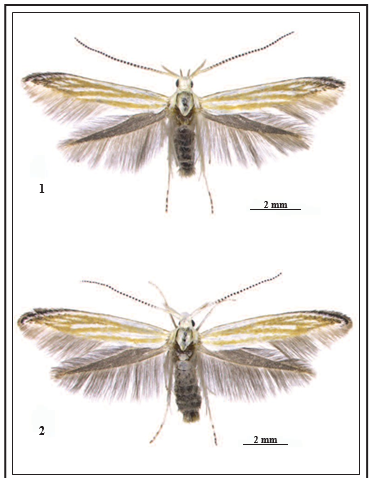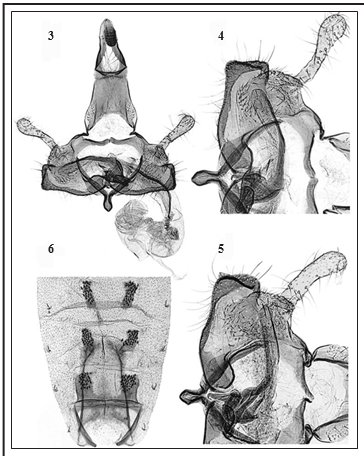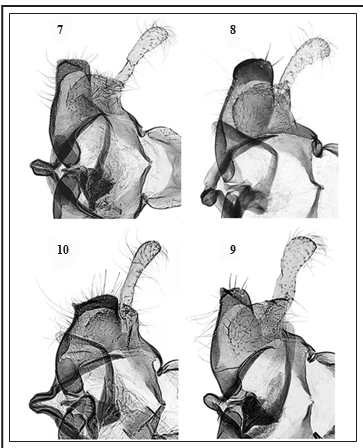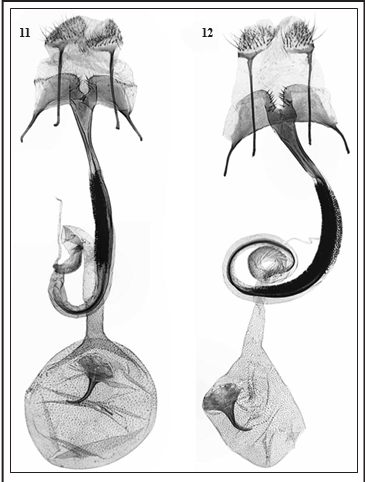

Coleophora curictae Baldizzone: a new species of theC. zelleriella Heinemann, 1854 group. Contribution tothe knowledge of the Coleophoridae. CXXXVI (Lepidoptera: Coleophoridae)
Coleophora curictaeBaldizzone: nuova specie del gruppo diC. zelleriella Heinemann, 1854. Contribuzioni alla conoscenza dei Coleophoridae. CXXXVI (Lepidoptera: Coleophoridae)
Coleophora curictaeBaldizzone: una nueva especie del grupo deC. zelleriellaHeinemann, 1854. Contribución al conocimiento de los Coleophoridae. CXXXVI (Lepidoptera: Coleophoridae)
Coleophora curictae Baldizzone: a new species of theC. zelleriella Heinemann, 1854 group. Contribution tothe knowledge of the Coleophoridae. CXXXVI (Lepidoptera: Coleophoridae)
SHILAP Revista de lepidopterología, vol. 44, núm. 175, 2016
Sociedad Hispano-Luso-Americana de Lepidopterología
Recepción: 20 Enero 2016
Aprobación: 28 Marzo 2016
Abstract: Coleophora curictae Baldizzone, n. sp., is described as a new species of Coleophoridae, belonging to the C. zelleriella Heinemann, 1854 group. C. melanograpta Meyrick, 1935 is the most similar species and it is known from the oriental Palaearctic zone. The new species can be positively identified only by genitalia examination.
Keywords: Lepidoptera, Coleophoridae, new species, Coleophora zelleriella group, Croatia, Montenegro, Italy, Lepidoptera, Coleophoridae, nuova specie, gruppo di Coleophora zelleriella, Croazia, Montenegro, Italia.
Sommario: Viene descritta Coleophora curictae Baldizzone, n. sp., nuova specie di Coleophoridae appartenente al gruppo di C. zelleriella Heinemann, 1854. La specie più simile è C. melanograpta Meyrick, 1935 conosciuta della zona paleartica orientale. La nuova specie può essere identificata con sicurezza solo mediante l’esame degli apparati genitali.
Resumen: Se describe Coleophora curictae Baldizzone, n. sp., una nueva especie de Coleophoridae próxima al grupo de C. zelleriella Heinemann, 1854. C. melanograpta Meyrick, 1935 es la especie más similar y es conocida de la zona Paleártica oriental. La nueva especie puede ser identificada positivamente sólo por el examen de la genitalia.
Palabras clave: Lepidoptera, Coleophoridae, nueva especie, grupo Coleophora zelleriella, Croacia, Montenegro, Italia.
In 1981 I published genitalia photos of Coleophora zelleriella Heinemann, 1854 in the context of a work showing some new synonyms. In Plate IV I showed some variations of the sacculus of the male genitalia. Figure 24 belonged to a specimen collected in Croatia, on the island of Krk; it showed the largest difference from the normal sacculus structure of C. zelleriella. I thought it was a variation since I had studied a number of specimens from Krk which had the normal sacculus and the same habitus. It was only in the following years that I understood that this was not only a variation but that it could be an undescribed species. The confirmation came in 2010 when from a locality on the island of Krk I collected both male and female specimens, and was able to verify that the female genitalia are very much different from those of C. zelleriella. I therefore examined all the specimens collected from Krk in my collection, finding several male specimens that I had identified as C. zelleriella based only on the habitus which is very similar for both species collected on the island. Afterwards I also studied a series of specimens collected in Italy (Friuli-Venezia Giulia and Lazio) and also identified two specimens collected in Montenegro by I. Richter.
Abbreviations:
Bldz = Giorgio Baldizzone IgR = Ignac Richter
PG, GP = Genitalia Preparation
LNMH = Latvian Museum of Natural History, Riga, Latvia MFSN = Museo Friulano di Storia Naturale, Udine, Italy
USNM = National Museum of Natural History, Washington D.C., USA
Coleophora curictae Baldizzone, sp. n.
Barcode Index Number: BOLD: AAM2030
Material examined: Holotype 1 “CROATIA, Island of Krk, Mt. Hlam, loc.[alità] Mestinjak, 170 m, 14-VII-2015 (lux), G. Baldizzone leg.” “PG Bldz nº 16112 1”, , coll. Baldizzone, Asti, Italy.
Paratypes: 3 11 (PG Bldz 16107, 16110), 1 0, idem; 6 11 (PG Bldz 15933), ibidem, 14-VII-2010 (lux), G. Baldizzone leg.; 1 1 (PG Bldz 16104), ibidem, 28-VI-2015 (trap.), G. Baldizzone leg.; 1 1 (PG Bldz 16105), Croatia, Krk, Mt. Hlam, Branusine, 180 m, 7-VII-2015 (lux), G. Baldizzone leg.; 1 1, ibidem, 16-VII-2015 (lux), G. Baldizzone leg.; 1 1 (PG Bldz 16088), ibidem, 18-VII-2015 (trap.), G. Baldizzone leg.; 1 1 (PG Bldz 16126), Croatia, Krk, Kampelje, Matijev Stan, 111 m, 28-VII-2005 (lux), G. Baldizzone leg.; 1 1 (PG Bldz 16043), ibidem, 15-VII-2007 (lux), G. Baldizzone leg.; 1 1 (PG Bldz 16127), 1 0 (PG Bldz 16045), ibidem, 10-VII-2010 (lux), G. Baldizzone leg.; 1 1 (PG Bldz 16048), Croatia, Krk, str. Krk-Vrbnik, Misugajnica, 30-VII-1975 (lux), G. Baldizzone leg.; 1 1 (PG Bldz 16129), ibidem, 6-VIII-1975 (lux), G. Baldizzone leg.; 1 1 (PG Bldz 16134), ibidem, 11-VIII1977 (lux), G. Baldizzone leg.; 2 11 (PG Bldz 16137, 16139), ibidem, 29-VII-1977, G. Baldizzone leg.; 2 11 (PG Bldz 2312, 16130), ibidem, 1-VIII-1978 (lux), G. Baldizzone leg.; 1 1 (PG Bldz 16132), ibidem, 4-VIII-1986 (lux), G. Baldizzone leg.; 2 11 (PG Bldz 9372, 16131), ibidem, 2-VIII1987 (lux), G. Baldizzone; 2 11 (PG Bldz 16136, 16138), ibidem, 20-VII-1988 (lux), G. Baldizzone leg.; 1 1 (PG Bldz 16135), ibidem, 23-VII-1988 (lux), G. Baldizzone leg.; 2 11 (PG Bldz 16140, 16141), ibidem, 3-VIII-1988 (lux), G. Baldizzone leg.; 1 0 (PG Bldz 16046), Croatia, Krk, str. Poljica Uvala Gavlena, 2.VII.2007 (lux), G. Baldizzone leg.
The above material is deposited in the Baldizzone collection; 1 1 (PG Bldz 14313) Croatia, Gornje, Bilisanie, 6-VII-2004, S. Tokár leg., coll. Tokár; 1 1 (GP 18502 IgR), 1 0 (GP 18493 IgR), MONTENEGRO, Dolovi, 2-VII-2012, I. Richter leg., coll. Richter; 1 1 (PG Bldz 15887), ITALY, Friuli-Venezia Giulia, Carso Triestino, Sistiana, Ceroglie, 150 m, 29-VI-2010, L. Morin leg., coll. MFSN; 1 1 (PG Bldz 16117), Italy, Lazio, Vallemare (RI), Colle Marcone, 1121 m, 3-VII-2010, M. Pinzari leg.; 1 1 (PG Bldz 16116), ibidem, 2-VIII-2012, M. Pinzari leg.; 3 11 (PG Bldz 16040), ibidem, 19-VII-2014, M. Pinzari leg.; 1 1 (PG Bldz 16037), ibidem, 20-VII-2014, M. Pinzari leg.; 2 11 (PG Bldz 16161), ibidem, 4-VII-2015, M. Pinzari leg.; 11 (PG Bldz 16159), ibidem, 11-VII-2015, M. Pinzari leg. These specimens are deposited in the collections of Pinzari and Baldizzone.
Diagnosis: Species of average size with ochreous forewings, darker towards the apex, striped white. Habitus similar to that of C. zelleriella, a variable species which normally has a lighter ochreous tonality and is more whitish. The genitalia provide easy determination between the two species: in the male of C. curictae the sacculus is more narrow and elongated, with a stumpy rounded tooth on the ventral angle, while C. zelleriella has a characteristic pointed tooth; the female genitalia of C. curictae has a long part of the ductus bursae covered with small spines while the ductus bursae of C. zelleriella is thin, completely devoid of spines. The species which is mostly similar to C. curictae is C. melanograpta Meyrick, 1935, which lives on various species of Quercus, known from China, Korea, Japan and the far East of Russia (Baldizzone et al., 2006), whose genitalia were illustrated by Baldizzone & Oku in 1990. In the male genitalia of C. melanograpta the lateral edge of the sacculus is more expanded and thickened, with the valva rounded and the lateral edge all compressed within the sacculus, while in C. curictae part of the lateral edge is visibly free, between the base of the cucullus and the dorsal angle of the sacculus; in the female genitalia of C. curictae the apophyses are more robust than those of C. melanograpta, and the posterior apophyses are shorter. The spinulate section of the ductus bursae is shorter, same as the median line and does not present the long central convolution. Another similar species to C. curictae is C. teregnathella Baldizzone & Savenkov, 2002, known from the far East of Russia, of which only the male genitalia are described; with respect to the male genitalia of C. curictae that of C. teregnathella has the spinulate part of the gnathos straight and longer, the tegumen broader and the lateral edge of the sacculus more straight, with a pointed triangular tooth on the ventral angle.
Description (Figs. 1, 2): Wingspan: 1 11-13 mm, 0 14-15 mm. Head white. Antenna: scape white, covered with a long tuft of erect scales, white on the outside and ochreous on the inside; flagellum ringed white and dark brown, except the basal 1/4 in the male and 1/5 in the female, where it is only ringed ventrally. Labial palpus white, with the second segment longer, about twice the third. Thorax and tegula white. Forewing more or less intense ochreous in colour, striped white: the costa has a thin ochreous line which at the apex is covered with a clear line of brown scales along the base of the costal fringe; a subcostal white stripe reaches the apex and runs under the line of brown scales; three short white stripes run on the radial veins and a longer stripe at the base of the cell; a white stripe runs along the anal vein which narrows towards the edge of the wing and a long stripe along the dorsum up to the start of the fringe. Costal fringe brown; dorsal fringe more or less light grey. Hindwing and fringe brown. Abdomen grey.
Note: The colour of the wings can be more or less intense according to the examined material but never represents the wide variations of C. zelleriella. Often older specimens have a more whitish appearance with the stripes barely visible because the ochreous-coloured scales are lost.
Male genitalia (Figs. 3, 4, 7): Spinulate part of the gnathos oblong. Tegumen large, medially elongated, proximally larger with two short pedunculi slightly dilated on the external edge. Cucullus elongated, larger at the apex. Transtilla thin and long. Valva large and elongated with a curved ventral edge and the outer edge straight or slightly convex. Sacculus well sclerotized, straightened and elongated with the ventral edge slightly curved and the lateral edge characterised by a large sclerotized protuberance with a small tooth on the ventral edge. Phallotheca arched, sclerotized only on the outside and dorsally at the apex. Cornuti numerous, in the shape of spines, held together in a long curved bundle.
Female genitalia (Fig. 11): Papilla analis very large, posterior apophysis twice as long as the anterior apophyses. Sterigma trapezoidal, wide as almost twice its length. Ostium bursae narrow and U- shaped, located on the distal edge of the sterigma. Colliculum in the shape of an elongated chalice with the lateral edges more sclerotized. Ductus bursae with the spinulate section twice the length of the sterigma; the ductus has a convolution where the median line ends and then it is transparent, continuing straight to the bursa copulatrix, which is round and has a large signum in the shape of a long stalked leaf.
Abdominal structures (Fig. 6): anterolateral bars almost 3 times as long as the posterolateral bars. Transverse bar straight with the proximal edge sclerotized. Tergal patches (3rd tergite) twice as long as their width, covered with 20-25 small spines.
Biology: Unknown. In analogy to C. zelleriella, this new species probably feeds on Quercus. On the island of Krk it was taken mostly at light, close to forests of Quercus pubescens, but also in an area of forest where there is only Q. petraea.
The species has only been collected with an actinic light trap and with a mixed of Wood’s and actinic lamps. The flight period is from the end of June up to the tenth of August, with the highest concentration of emergences in the middle of July. On the island of Krk as well as in Lazio (Vallemare) it flies together with C. zelleriella.
Distribution: The species is known from Croatia, Montenegro and Italy (Friuli-Venezia Giulia and Lazio).
Etymology: The name of the new species is derived from Curicta, the name that the Romans used to call the island of Krk.

Coleophora curictae Baldizzone, sp. n., Holotypus 1 (photo taken before the abdominal dissection). 2. C. curictae Baldizzone, sp. n., 0: Croatia, Island of Krk, Hlam, loc. Mestinjak, 172 m, 14-VII- 2015 (lux), G. Baldizzone leg., coll. Baldizzone.

C. curictae Baldizzone, sp. n., male genitalia: (PG Bldz 16107) Croatia, Island of Krk, Hlam, loc. Mestinjak, 172 m, 14.VII.2015 (lux), G. Baldizzone leg., coll. Baldizzone. 4. C. curictae Baldizzone, sp. n., male genitalia: enlarged detail. 5. C. curictae Baldizzone, sp. n., male genitalia, same detail (PG Bldz 16134) Croatia, Krk, str. Krk-Vrbnik, Misugajnica, 11-VIII-1977 (lux), G. Baldizzone leg., coll. Baldizzone. 6. C. curictae Baldizzone. sp. n., male abdomen (PG Bldz 16141) Croatia, Krk, str. Krk-Vrbnik, Misugajnica, 3-VIII- 1988, G. Baldizzone leg., coll. Baldizzone.

C. curictae Baldizzone, sp. n., male genitalia: enlarged detail (PG Bldz 15887) Italy, Friuli-Venezia Giulia, Carso Triestino, Sistiana, Ceroglie, 150 m, 29-VI-2010, L. Morin leg., coll. MFSN. 8. C. melanograpta Meyrick, male genitalia, enlarged detail (PG Bldz 6845) Japan, Hosyû, Kinki, Nisinomyia, 7-VII-1949, S. Issiki leg., coll. USNM. 9. C. teregnathella Baldizzone & Savenkov, male genitalia: enlarged detail (PG Bldz 11603 - holotype) Far East of Russia, Primorskij Kraj, Shkotovo distr., Anisimovka, 20-VII-1994, N. Savenkov leg., coll. LNMH. 10. C. zelleriella Heinemann, male genitalia: enlarged detail (PG Bldz 16111) Croatia, Island of Krk, Hlam, loc. Branusine, 180 m, 7-VII-2015 (lux), G. Baldizzone leg., coll. Baldizzone

C. curictae Baldizzone, sp. n., female genitalia (PG Bldz 16045) Croatia, Krk, Kampelje, Matijev Stan, 111 m, 10-VII-2010, G. Baldizzone leg., coll. Baldizzone. 12. C. melanograpta Meyrick, female genitalia (PG Bldz 6844) Japan, Hosyû, Kinki, Nisinomyia, 1-VII-1949, S. Issiki leg., coll. USNM
BIBLIOGRAPHY
BALDIZZONE, G., 1981.– Contributions à la connaissance des Coleophoridae, XXII. Nouvelles synonymies dans le genre Coleophora Hübner (II).– Nota lepidopterologica, . (3): 63-79.
BALDIZZONE, G. & OKU, T., 1990.– Descriptions of Japanese Coleophoridae III.– Tyô to Ga, 41 (2): 97-112.
BALDIZZONE G. & SAVENKOV, N., 2002.– Casebearers (Lepidoptera: Coleophoridae) of the Far East region of Russia. I. (Contribution to the knowledge of Eastern Palaearctic Insects 12).– Beiträge zur Entomologie, 52 (2): 367-405
BALDIZZONE, G., van der WOLF, H. & LANDRY, J., 2006.– Coleophoridae, Coleophorinae (Lepidoptera).– In B. LANDRY ed. World Catalogue of Insects, 8: 1-215.